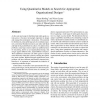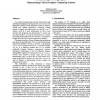623 search results - page 63 / 125 » The role of trust in distributed design |
CCS
2009
ACM
14 years 2 months ago
2009
ACM
Mandated requirements to share information across different sensitivity domains necessitate the design of distributed architectures to enforce information flow policies while pr...
SRDS
2007
IEEE
14 years 2 months ago
2007
IEEE
Fault tolerant distributed protocols typically utilize a homogeneous fault model, either fail-crash or fail-Byzantine, where all processors are assumed to fail in the same manner....
SIGMOD
2008
ACM
14 years 7 months ago
2008
ACM
Mobile devices equipped with positioning capabilities (e.g., GPS) can ask location-dependent queries to Location Based Services (LBS). To protect privacy, the user location must n...
AAMAS
2008
Springer
13 years 7 months ago
2008
Springer
As the scale and scope of distributed and multi-agent systems grow, it becomes increasingly important to design and manage the participants' interactions. The potential for b...
ECBS
1996
IEEE
13 years 12 months ago
1996
IEEE
It is widely recognized that real-time,fault-tolerant and distributed computing technologies play a key role in the deployment of many current andfuture (civilian or Defense) crit...


